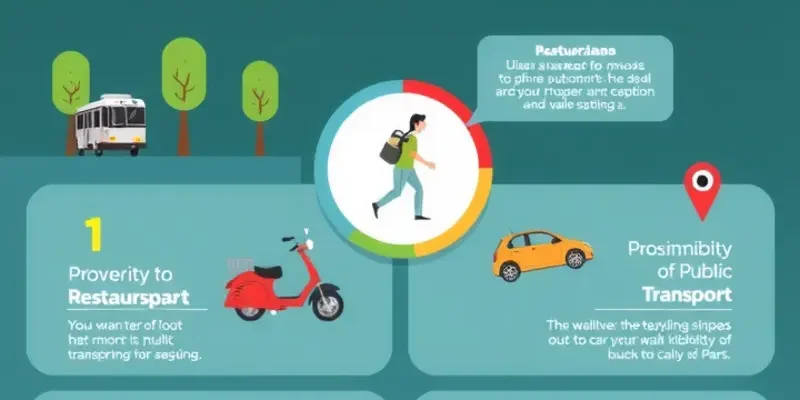Looking for a new apartment? While the allure of a shiny new kitchen or spacious living room can cloud your judgment, there’s a critical yet often overlooked factor that could change your rent game completely: the walkability score. For first-time renters, young professionals, couples, and families, understanding your neighborhood’s walkability can mean the difference between a daily coffee run turn into a delightful stroll or dragging your tired feet to the car. You don’t want to find yourself stuck in a place where the closest grocery store is a 20-minute drive and every trip for snacks feels like an expedition! In today’s article, we’ll break down what walkability scores really mean, why they should matter to you, and how improved mobility can enhance your lifestyle—from squashing your morning stress to providing endless weekend adventure opportunities. So lace up your sneakers; we’re about to hit the pavement!
The Walkability Score: What Is It and Why Should You Care?

A walkability score, the modern metric of neighborhood convenience, plays a pivotal role in urban living. It quantifies how friendly a community is to walkers, assessing how easily daily needs can be met by foot. A walkability score reflects access to essential destinations like schools, shops, parks, and public transit. This score, increasingly influential in urban real estate, has become a core criterion for housing decisions.
Calculating a walkability score involves evaluating proximity to public services and amenities. Generally, analysts assess the distance from residential locations to vital points of interest. These might include grocery stores, cafes, libraries, and entertainment venues. Walkability assessment tools weigh the variety and density of these places, crafting a nuanced picture of pedestrian accessibility. Urban planning principles and real-world pedestrian pathways also factor into these metrics, using an algorithm that considers both distance and ease of accessibility.
The essence of walkability isn’t solely about reducing travel times or enhancing convenience. It profoundly affects commuting habits, leisure opportunities, and mental well-being. By opting for a high walkability score neighborhood, residents often find themselves less reliant on vehicles, thus minimizing daily commutes. This can lead to reduced transportation expenses and less vehicular pollution, both beneficial for personal finances and the broader environment.
Leisure activities, too, are more abundant in walkable locales. Here, the simple act of walking becomes a preferred pastime, a seamless blend of exercise and exploration. Everyday leisure can be more spontaneous, with parks, cultural venues, and eateries in close proximity. This aspect turns a neighborhood into a vibrant ecosystem, fostering community interaction and local commerce.
From a wellness perspective, walkability impacts both physical and mental health. Communities with higher walkability scores tend to see increased physical activity levels, correlating with reduced risks of lifestyle diseases. Furthermore, the mere act of walking offers mental health benefits, reducing stress and improving mood through both physical exercise and the opportunity to engage with one’s surroundings.
Choosing where to live based on walkability is an increasingly strategic decision for many renters. As choices are made, considering walkability can enhance quality of life in unexpected ways—aligning lifestyle with convenience, health, and social engagement. For those navigating these decisions, resources like our apartment hunting guide with allergies in mind can offer added dimensions of consideration.
Ultimately, the walkability score provides more than a glimpse into a neighborhood’s infrastructure. It speaks to an evolving urban landscape where convenience, well-being, and environmental consciousness intersect. Potential renters and buyers alike find themselves increasingly prioritizing these scores, looking beyond mere square footage or aesthetic appeal, towards creating a lifestyle rooted in ease, connectivity, and vitality.
Steps to Your New Home: Finding the Right Walkable Neighborhood

It’s time to tie up those walking shoes and embark on the pursuit of the perfect apartment in a neighborhood that won’t have your pedometer gasping for breath. But where to begin? Well, when it comes to searching for apartments with high walkability scores, putting a few smart tools in your toolbox can transform this task from baffling to brilliant.
Let’s start with some digital guidance. A quick stroll through the internet will reveal a bevy of websites dedicated to city walkability scores. These sites often rank neighborhoods based on proximity to shops, restaurants, parks, and public transportation. The higher the score, typically, the less likely you’ll suffer from a tragic “Oh no, I forgot the milk” grocery drama. And who doesn’t want to trade in the revving car engine for the serene sound of sneakers padding down the pavement?
In your search for a walkable wonderland, consider using map-based tools that allow you to visualize amenities with eerie precision. Picture this: entering your potential address and watching as coffee shops, movie theaters, and dry cleaners pop up like friendly little blue pins, eager to serve you without a car journey. Voilà! You’ve got a sneak peek into your potential daily adventures on foot.
But don’t just share your day with software and screens. Get your shoes onto those sidewalks! Before committing to a lease, pay a visit to a neighborhood you’re eyeing. Walk around at different times of the day. Listen. Observe. Smell the fresh-baked goodness wafting from the bakery you’ve never noticed before. Feel the neighborhood vibe if it’s one of bustling foot traffic or eerily quiet sidewalks.
Here’s a twist: Talk to the locals. Capture their honest opinions about the neighborhood’s walkability. Sometimes, they’ll reveal hidden gems or, conversely, lurking pitfalls. Perhaps the evening foot traffic turns into vehicular mayhem that not even the most strategic jaywalking could navigate!
When evaluating a neighborhood, keep an eye on safety. Well-lit streets that feel secure are just as important as proximity to the nearest Thai restaurant. Research crime rates and if possible, check out local community boards for recent news. Navigating the world of renter safety might seem daunting, but it’s a key criterion that ensures your evening strolls are under streetlights, not shadows.
Finally, remember: balance is key. A high walkability score doesn’t mean all amenities need to be within arm’s reach. Sometimes, having just a few essential essentials a stone’s throw away is enough to make daily life feel less like a series of car trips and more like a leisurely amble. So whether you’re a cafe hopper or a park enthusiast, find a neighborhood that matches your rhythm.
Finding the perfect walkable neighborhood isn’t just about the numbers—it’s about finding that sweet spot between ligging and living. Once you’ve dived into both the data and the delightful realities of potential neighborhoods, you’ll be well on your way to stepping into your new home sweet home.
Final words
When searching for your next apartment, don’t just look at the square footage or the beautification of your unit. Pay close attention to the walkability score of your new neighborhood. Combining daily errands with a healthy lifestyle and a community vibe can make a world of difference in your renting experience. You’ll find yourself eating fewer UberEats and reveling in the joy of spontaneous evenings out, all without the hassle of parking! So, next time you’re on the hunt for your next home, remember: a walkable neighborhood might just be your new best friend! And who would say no to a home where your feet can take you everywhere? Ready to step into a new lifestyle?









